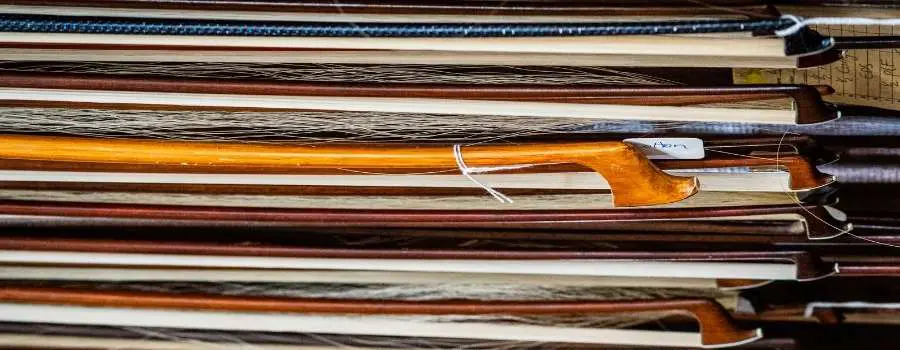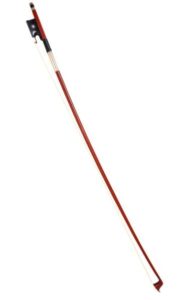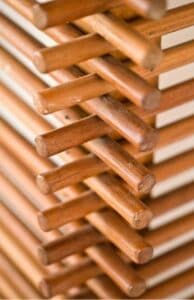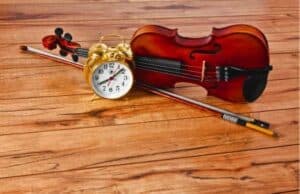
I love things that appear simple at first but as you explore them you realize how complex and nuanced they are. Violin bows fit this description perfectly.
From the various materials used to create them to learning about how to care for them…every topic I researched lead me to more questions.
As a film composer, I love to try things in order to create interesting sounds and textures. When researching violin bows I came across a few things I hadn’t considered before, so this information isn’t just for potential violinists but also for composers and sound designers who want to learn a little more about this deceptively simple tool.
How Tight Should A Violin Bow Be?
As you tighten your bow look for a width at the center of about 8mm between the wood and the hair, or roughly the width of the tip of a pinky finger. Too tight and this distance is increased, too loose and the distance is decreased.
We all (should) have pencil’s in our instrument cases or gig bags, if you’re unsure if your pinky is the right size to gauge the distance, then use that handy pencil. Slip it between the wood and bow hair at the middle…it should slide right between the two.
Just remember, once you’re done playing, loosen the bow to take the tension off the wood and the hair. Bows that are left under tension tend to lose their rigidity and possibly crack or break over time.
Over tightening should also be avoided since this will take too much bend out of the bow stick and will put too much strain on the bow hair. This extra strain can stretch or break the bow hairs. It also leads to stripping the tightening screw at the base of the bow, this can lead to the screw losing its integrity which means the bow hair may loosen as you play.
Are Violin Bows Supposed To Be Bent?
Violin bows should have an even, gradual curve to them. As the bow is tightened the bow will straighten and pull the bow hair taught. What is not normal is if the bow is curving left or right. Violin bows should curve downward towards the bow hair but should be straight when looking down from the top.

A violin bow acts as a sort of tension spring. When bows are created, the luthier will work a downward curve into the wood. When bow hair is attached to the bow and the screw is tightened, it will straighten the bow out increasing the distance from the screw to the tip. As this distance increases it pulls the bow hair taught allowing the player to properly rosin the bow and play.
When the player is finished, they turn the screw the other way which allows the bow stick to bend back.
Even when tightened for playing purposes, the violin bow stick should never be completely straight. If you have completely straightened your bow, then you are potentially damaging the tightening screw, the bow stick itself, and especially the bow hair.
Your violin bow should never have a curve from to the left or right when looking straight down from the top. This is considered a warped bow and can lead to damaging the bow hair since it is creating uneven tension.
Why Are Some Violin Bows Round And Others Octagonal?
The reason some violin bows are round and others are octagonal is purely an aesthetic choice made by the maker. Sound, durability, and playability of round bows and octagonal bows are identical. The biggest difference is octagonal bows are more difficult to make and will usually cost a bit more.
In-depth studies haven’t been made but one professor, Voichita Bucur of RMIT University, did note a stiffness to mass ratio difference of .2% in favor of octagonal bows.
So octagonal bows are “technically” stronger, but Bucur didn’t go into detail about his experiment so we have no way of knowing his measurement method or control. Besides, .2% is such a minuscule amount that it really means there is no practical difference from a player’s perspective.
The only real difference is in the production. Makers of octagonal bows do note that they are more difficult to make but again, this has no bearing from a player perspective. However, the player will notice the steeper price tag since octagonal bows typically cost 10-20% more than rounded bows thanks to the increased difficulty in manufacturing them.
The vast majority of string players in an orchestra will have rounded bows, so if you want to be unique then check out some octagonal bows. The aesthetics are purely for you and the player sitting next to you though since the audience won’t be able to tell the difference.
Does Violin Bow Quality Really Matter?
Violin bow quality does matter, but that doesn’t mean expensive equals good quality. You’ll want to try many bows made of different materials and weights to see which one reacts best with your violin.
There is that old saying that you get what you pay for. Cheaply made (and therefore usually less expensive) violin bows are likely going to wear out more quickly and need to have the bow hair replaced much more often.
The bow sticks themselves and tightening mechanism will also be more likely to warp, crack and lose their structural integrity.
New players might find cheaply made bows frustrating to play with since their balance can be off, the bow hair might not take rosin well, and the bow may not tighten enough…it’s like a fast-food burger compared to a gourmet burger. Both fill you up but the gourmet burger will be custom made just for you rather than mass-produced to “please the majority of people.”
Some players, usually after they’ve played for a while, might purchase a less expensive bow but then have it re-haired with higher quality bow hair.
Bottom line, expensive doesn’t always mean quality. But at the same time, more expensive bows are usually more hand-made and are produced in less quantity than machine-made cheaper bows.
When it’s time to purchase a new bow, try as many as you can and don’t let people tell you what you “should” use… a purist will never be caught dead using a carbon fiber bow, but that might be the perfect choice for you.
What Are Violin Bows Made Of?
Violin bows are usually made from durable wood such as Sandalwood or Pernambuco and bow hair that is made from horsehair. Synthetic materials, like carbon fiber bow sticks and synthetic horsehair, are also used.

Natural wood bows with natural horsehair are still the most popular available. Sandalwood is usually less expensive while Pernambuco is typically used for top-of-the-line bows.
Carbon fiber bow sticks are growing in popularity due to their durable yet lightweight characteristics. Some people like a hybrid bow stick that’s made of carbon fiber and then covered in natural wood.
I go into more detail about horsehair versus synthetic hair below, but there is growing popularity in synthetic bow hair due to its sustainability and durability.
Are Horses Harmed To Make Bows?
Horses are not harmed in order to make violin bows. The hair used to making violin and other strings instrument bows comes from horses that have already died. Sometimes horsetails are trimmed while the horse is alive, but it is done carefully to ensure the animal isn’t hurt or stressed.
While it’s not everyone’s first thought when they are having a beloved animal put down, try to get the horse’s tail if you can. The vet will usually remove the tail anyways for various medical reasons and you may want to have it as a keepsake anyways.
If you’re not emotionally attached then getting the tail can be lucrative since it can then be sold to instrument and bow makers (luthiers.) The current rate for horse hair is between $150 and $400 per pound, depending on the breed and quality.
People with an aversion to using natural animal materials have created a demand for synthetic bow hair. Like carbon fiber bow sticks, synthetic bow hair is more durable than natural bow hair. It won’t wear out or be damaged by changes in humidity and can theoretically last much longer than natural horsehair bows.
The downside to synthetic horse hair is that purists will say it doesn’t take rosin the same way and that you have to use more pressure when playing…others disagree.
How Do I Know If My Bow Has Enough Rosin?
The whole point of rosin is to create traction for the bow hair to grip and release the strings on a violin.
You will need to add more rosin to your violin bow if it is not gliding smoothly over the strings. Your tone should be full and resonant, so if the sound is faint or scratchy then should re-rosin your bow.
On the other hand, it is also possible to over rosin your bow. When this happens the bow will feel sticky against the string. One sign that you’ve applied too much rosin is if you see puffs of rosin dust as you play.
This dust can get into your eyes and cause irritation and will also fall onto the face of your violin and potentially damage the surface.
When applying bow rosin, do so in long, even strokes to ensure you don’t over-apply in some areas and under-apply in others. Usually, four or five of these strokes will do the trick.
Make sure you don’t touch the bow hair with your fingers. Oils that we naturally produce get onto the hair and make it difficult for the rosin to stick. The natural salts and acids that we have in our skin will also eat away at the bow hair.
When you are finished playing, use a soft towel to remove the rosin from the bow and also from the strings of the violin. If you don’t then the next time you play this excess rosin will go onto your bow, building up and caking on over time.
Speaking of bow rosin, check out this article for 11 Things You Need To Know About Bow Rosin
Does A Violin Bow Work On Guitars?
You can use a violin bow on a guitar but you may find it difficult to play one note at a time since a guitar body is flat. This means that the strings sit at the same level instead of a curve like on a violin. Les Paul guitars do have a curve making bowing them easier than other guitars.
With practice…using a bow on a guitar is slightly awkward at first…and with some good effects, you can get your inner Led Zeppelin on.
While the sound that’s produced is unique, it’s not for everybody. It’s really more for an effect than for a standout melody. Many players have a difficult time playing single notes since the bridge of a guitar isn’t curved and all the strings lay at the same level. Playing the low and high “E” is easier since these strings are on the outside of the set.
Some people have solved this by using an E-Bow. While not quite the same as standard bowing, the E-Bow creates a more playable “bowing” sound since it’s designed to straddle the target string. Once it’s in place the string will continuously vibrate via a magnetic field that’s created by the E-Bow.
How Long Does A Violin Bow Last?
There are two primary things that will need replacing on a violin bow, the stick itself and the bow hair.
On average, a student will need to have the bow hair replaced about every two years. Professional players and musicians that practice and perform a lot may need to replace their bows hair every six months. As for the stick itself, if properly taken care of the stick can last decades if not a lifetime.

To clarify, bow hair that is not abused and is properly rosined can last a student who practices 30-60 minutes a day 18-24 months.
Performers who are practicing and playing 2-6 hours a day will need to replace the hair of the bow every 6 months to a year.
In both cases the stick itself, if maintained properly can last for several decades to a lifetime.
To make sure your bow stick lasts a long time, make sure that wooden bows are kept in a humidity-controlled environment. Too wet or too dry will cause the wood to warp or crack.
Make sure that bow tension is released when you are finished playing otherwise, you could take the bend out of the bow which means you won’t be able to tighten the bow hair as much as needed.
Of course, new materials are being used to make violin bows such as carbon fiber and carbon fiber/wooden hybrids. These models tend to be much more durable while still maintaining average bow weights players like.
How Much Does A Violin Bow Weigh?
Full-sized violin bows will typically weigh about 60 grams. Of course, this weight can vary depending on the maker and the material used to create the bow. On the lighter end, a violin bow can weigh 55 grams, and on the heavier end weigh 65 grams.
These numbers are just ballparks and some players have played bows as light as 54 grams while others have played bows that are closer to 70 grams.
| Violin Bow Material | Violin Bow Size (Average) | Violin Bow Weight (Average) |
| Carbon Fiber | 29.5 in (Full Size) | 62 grams |
| Carbon Fiber | 24.5 in (1/2 size) | 53 grams |
| Sandalwood (Wood) | 29.5 in (Full Size) | 61 grams |
| Pernambuco (Wood) | 29.5 in (Full Size) | 60 grams |
| Carbon Fiber/Wood Hybrid | 29.5 in (Full Size) | 60 grams |
When choosing a violin bow it is very important to go into your local music shop and try many sizes and brands. A heavier bow might feel better gliding over the strings, but remember that extra weight will start to feel like a log after hours of playing.
On the other hand, a lighter bow might be more comfortable to play for long periods but will require more downward pressure for more aggressive playing which can fatigue your muscles quickly.
What Is It Called When You Play With The Stick Of The Bow?
Col legno is the playing technique violin players use to create a percussive strike against the strings of their instruments. Col legno translates to “with the wood,” and it produces a melodic percussive sound that has both wooden and metallic qualities.
Col legno is actually the shortened version of col legno battuto and in music is typically shortened further to just Col Leg.
Some violin players will have a spare less expensive, or more durable bow that they will use if a piece requires col legno…especially if it’s particularly aggressive or very long passages. Other players will use pencils or wooden dowels to perform the technique.
Film composers love writing col legno in violin and string parts because of its unique sound. While a lot of “classical” tunes (looking at you “Mars, Bringer of War”) will use a rhythmic col legno (all players playing an eighth note pattern, for instance) many film composers will instruct players to lightly tap random notes in a random pattern. This version of col legno creates an eery, agitated sound.
